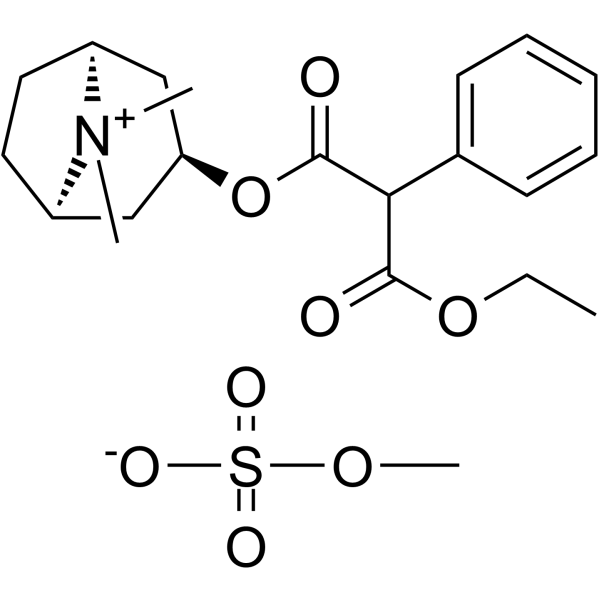
Tematropium
CAS No. 113932-41-5
Tematropium( CDDD3602 | HGP6 | Tematropium metilsulfate )
Catalog No. M26098 CAS No. 113932-41-5
Tematropium (CDDD3602) is an anticholinergic.
Purity : >98% (HPLC)
 COA
COA
 Datasheet
Datasheet
 HNMR
HNMR
 HPLC
HPLC
 MSDS
MSDS
 Handing Instructions
Handing Instructions
| Size | Price / USD | Stock | Quantity |
| 2MG | 447 | Get Quote |


|
| 5MG | 709 | Get Quote |


|
| 10MG | 972 | Get Quote |


|
| 25MG | 1467 | Get Quote |


|
| 50MG | 1971 | Get Quote |


|
| 100MG | 2682 | Get Quote |


|
| 200MG | Get Quote | Get Quote |


|
| 500MG | Get Quote | Get Quote |


|
| 1G | Get Quote | Get Quote |


|
Biological Information
-
Product NameTematropium
-
NoteResearch use only, not for human use.
-
Brief DescriptionTematropium (CDDD3602) is an anticholinergic.
-
DescriptionTematropium (CDDD3602) is an anticholinergic.
-
In Vitro——
-
In Vivo——
-
SynonymsCDDD3602 | HGP6 | Tematropium metilsulfate
-
PathwayOthers
-
TargetOther Targets
-
Recptor——
-
Research Area——
-
Indication——
Chemical Information
-
CAS Number113932-41-5
-
Formula Weight457.54
-
Molecular FormulaC21H31NO8S
-
Purity>98% (HPLC)
-
SolubilityIn Vitro:?DMSO : 250 mg/mL (546.40 mM)
-
SMILESCOS([O-])(=O)=O.CCOC(=O)C(C(=O)O[C@@H]1C[C@@H]2CC[C@H](C1)[N+]2(C)C)c1ccccc1
-
Chemical Name——
Shipping & Storage Information
-
Storage(-20℃)
-
ShippingWith Ice Pack
-
Stability≥ 2 years
Reference
1.Taha AY, et al. Selective reduction of excitatory hippocampal sharp waves by docosahexaenoic acid and its methyl ester analog ex-vivo. Brain Res. 2013 Nov 6;1537:9-17.
molnova catalog



related products
-
VT107
VT107 is a potent pan-TEAD autopalmitoylation inhibitor. VT-107 can be used in cancer therapy research.
-
14-Episinomenine
14-Episinomenine is an alkaloid that can be isolated from Stephania cepharantha.
-
Rhodamine?B
Rhodamine?B is used as a tracer dye in water to determine the rate and direction of flow and transport.



 Cart
Cart
 sales@molnova.com
sales@molnova.com


